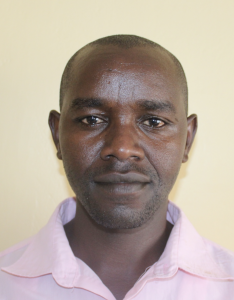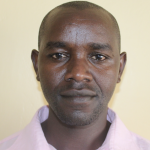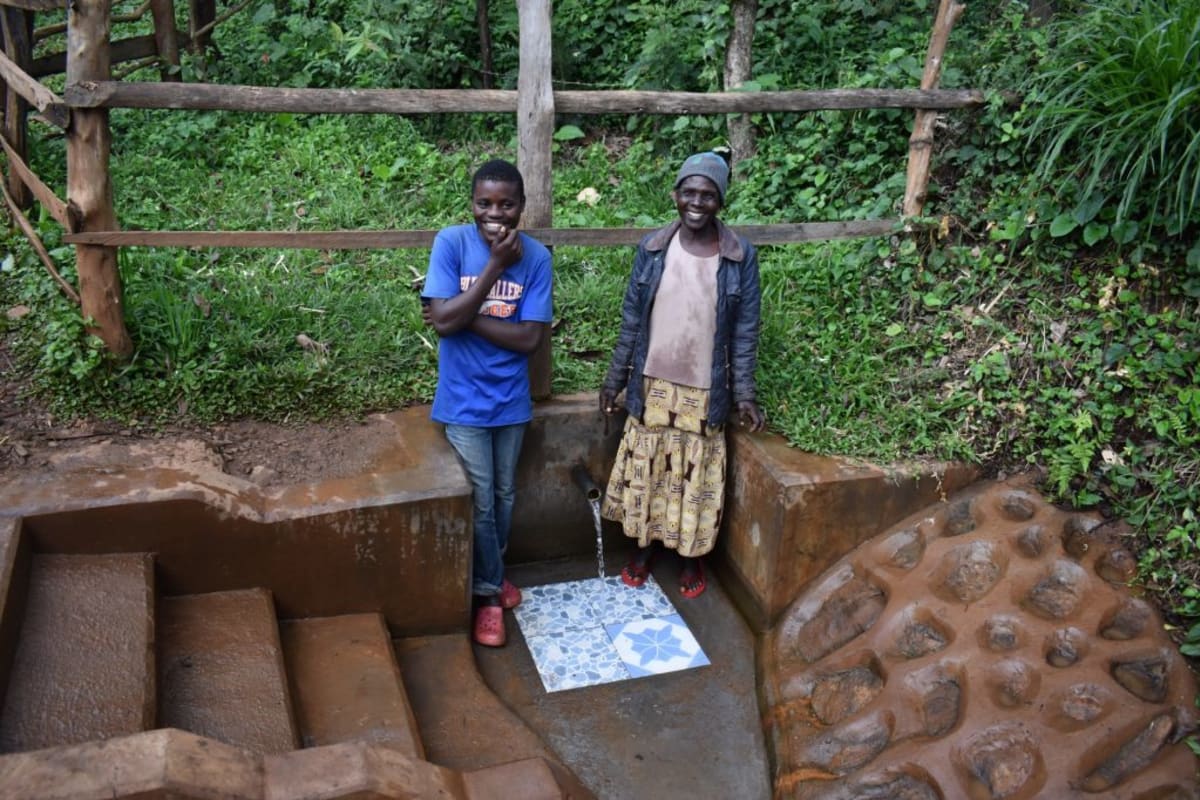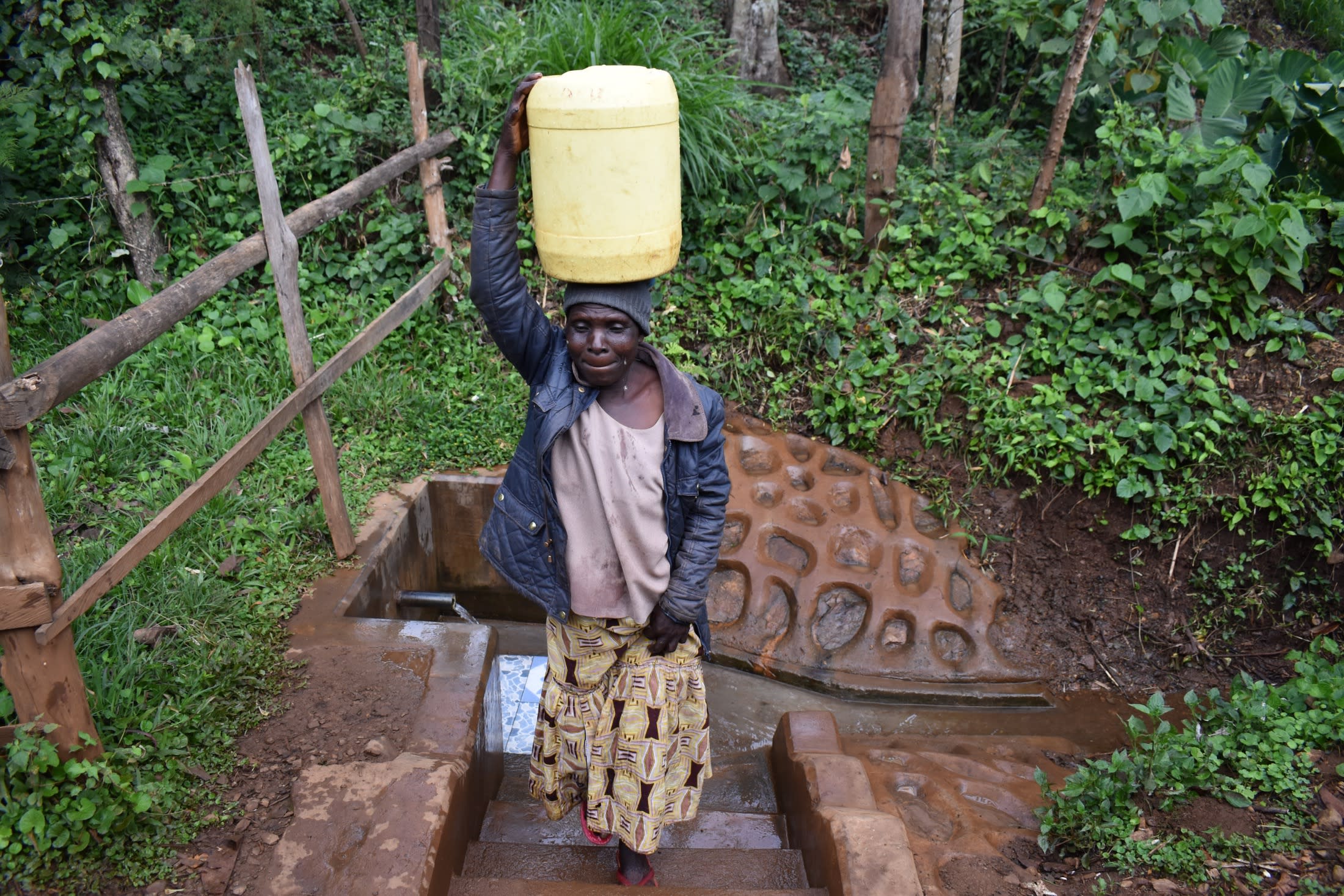July, 2020: Harambee Community, Elijah Kwalanda Spring Project Complete!
Please note, all photos in this report were taken before social distancing recommendations went into effect.
Harambee Community now has access to clean water! Elijah Kwalanda Spring has been transformed into a flowing source of water thanks to your donation. We protected the spring, constructed 5 sanitation platforms for different households in the community, and we trained the community on improved sanitation and hygiene practices in addition to COVID-19 prevention.

Women at the spring
"Good health will always be my portion, as I will be consuming safe, clean water from the protected spring which now looks so nice and well-constructed. I will be able to improve my living standards by using the finances meant for medication to acquire essential goods and items for my family like food, and even paying fees for my kids at school so they can learn and succeed in life," said Knight Mutoro, who was elected Secretary of the new Water User Committee.

Knight Mutoro, pictured at training holding her manual after being elected Secretary of the new Water User Committee
Children were just as excited as the adults about the new water point.
"The then-unprotected source was a threat to my health and life at large. After protection, I can now with a lot of confidence say that I will be able to live long because of the availability of safe water from the spring," said teenager Venezer.

Venezer
"Since I will be accessing safe clean drinking water, I will always go to school and spend much time learning without being sick, therefore, improving on my academic performance by scoring high grades."

Venezer enjoying the completed spring
Preparing for Spring Protection
Community members worked together to source and carry all locally available construction materials to the spring. These included bricks, sand, stones, and fencing poles. Some people also chiseled away at large stones to break them down into gravel. Because people have to carry most items by hand, the materials collection process can take anywhere from a few weeks to months.
When everything was prepared, we sent a lorry to the community to deliver the rest of the construction materials including the cement, plastic tarps, and hardware. Then, our artisan and field officers deployed to the spring to begin work. While the field officers traveled to and from the site each day throughout the construction process, the artisan remained in the community. To accommodate him, individual households provided meals and a place to sleep each night.
The last step before construction commenced was taking a water sample from the unprotected spring. We sent the sample to a government laboratory for testing to identify the kinds of contaminants in the water before its protection. These often include fertilizers and pesticides from farms, animal and human feces, and any number of harmful bacteria. We then shared the test results with the community to identify extra steps they could take to help ensure the spring’s water remains clean and safe after protection.
From Open Source to Protected Spring: A Step-by-Step Process
At last, it was time to dig in at the spring! Women and men lent their strength to the artisan each day to help with the manual labor. First, we cleared and excavated the spring area. We dug a drainage channel below the spring and several surface runoff diversion channels above and around the spring. These help to divert the environmental contaminants identified in the pre-construction water quality test.

Site clearance and excavation begin
To ensure community members could still fetch water throughout the construction process, we also dug temporary diversion channels from the spring’s eye around the construction site. This allowed water to flow without severely disrupting community members’ water needs or construction work.
Excavation created space for setting the spring’s foundation made of thick plastic tarp, wire mesh, concrete, and waterproof cement. After setting the base, we started brickwork to build the headwall, wing walls, and the stairs.

Laying the first bricks on the concrete foundation
Next, we began one of the most crucial steps of spring protection to ensure a fully functional water point: setting the discharge pipe. The discharge pipe has to be set low enough in place in the headwall so that the water level inside never rises above the spring’s eye, yet high enough to leave 18-20 inches between the pipe and the spring floor to allow room for the average jerrycan (a 20-liter container) to sit beneath the pipe without making contact.

Wall construction
If the discharge pipe were placed too high above the spring’s eye, too much backpressure could force the flow to emerge elsewhere. Too low, and community members would not be able to easily access the water. We embedded the pipe using clay (or mortar when the clay is in short supply) and placed it at a slight incline to ensure water flows in the right direction.

Setting the pipe
In coordination with brickwork, we pitched medium to large stones on both sides of the spring’s drainage channel. We then cemented and plastered each stone group into place, forming the rub walls. These help to discourage people and animals from trying to stand on that area, which could cause soil erosion and thus a clogged drainage area.

Stone pitching
With brickwork and stone pitching completed, we turned to cement and plaster both sides of the headwall and wing walls. This reinforces the brickwork and prevents water in the reservoir from seeping through the walls. In turn, this builds enough pressure in the reservoir box to push water out through the discharge pipe.

Artisan plasters interior headwall
As the headwall and wing walls were curing, we cemented and plastered the stairs and installed 4 tiles beneath the discharge pipes. The tiles protect the concrete from the erosive force of the falling water, beautify the spring, and facilitate easy cleaning of the spring floor.

Setting the tiles
With the tiles in place, we transitioned to the final stages of construction - backfilling the reservoir box. First, we cleared the collection box of any debris that may have fallen in since its construction such as dead leaves or other items. Then we redirected the temporary diversion channels back into the reservoir box, channeling water into this area for the first time. We closed off all of the other exits to start forcing the water through the discharge pipe only.

Backfilling with clay
With much help from the community, we filled up the reservoir area with the clean and large stones they gathered, arranging them in layers like a well-fitting puzzle. We covered the stones with a thick plastic tarp to minimize potential sources of contamination from aboveground, followed by a layer of soil. We piled enough soil on top to create a slight mound to compensate for the backfill’s future settlement.

Backfilling with stones
Community members transplanted grass onto the backfilled soil to help prevent erosion. Finally, the collection area was fenced in to discourage any person or animal from walking on it since compaction can lead to disturbances in the backfill layers and potentially compromise water quality.

Fencing and planting grass
The entire construction process took about 2 weeks of work and patience to allow the cement and plaster to finish curing. As soon as it was ready, people got the okay from our field officers to begin fetching water.

We met them there to celebrate this momentous occasion. Happiness, thanksgiving, and appreciation were the order of the day flowing in all directions.

The community members were happy to begin accessing safe and clean water. According to Mr. Keri Tsimonjere, who was elected Chair of the new Water User Committee, since 1955 when the spring was discovered, efforts after efforts had been fronted by predecessors of the village but all in vain as nobody had been able to even attempt to construct the spring.

Mr. Keri Tsimonjere takes a cold drink of spring water
The closest they got was only availing the large stones for backfilling, which were delivered near to the spring in 1992 but no other materials were provided to facilitate the process of construction.

Furthermore, Mr. Tsimonjere exclaimed that he has never seen such a well-constructed spring as this in the entire location.
Sanitation Platforms
All 5 sanitation platforms have been completed and handed over to their new owners. These 5 families are happy about this milestone of having a private latrine of their own and are optimistic that people will no longer leave waste outdoors.

Mr. Tsimonjere stands proudly with his new sanitation platform
We are continuing to encourage families to finish building walls and roofs over their new latrine floors, and for other families to replicate the design after having helped construct these examples.

New Knowledge
Community member Timothy Kwalanda helped organize the training in coordination with our team. Together we found the community’s preferred date for training while considering other events in the community calendar such as the agricultural season and expected gatherings. When the day arrived, Facilitators
Victor Musemi and Wilson Kipchoge deployed to the site.
14 people attended training, which was held at Timothy Kwalanda's homestead. Being a cool afternoon, participants chose to have training while seated on the bare ground covered with very green grass and surrounded by flowers. The whole area looked beautiful and was conducive for training.

All eyes on Trainer Wilson Kipchoge; a leaky tin handwashing station in the foreground
The attendance was not as we had expected because one of the community members whom we had asked to attend the training, the area village elder, passed on that very morning leaving the members in a shock given that she had been approached by one of the community members the previous evening. But with this occurrence, we were able to proceed with the training as was planned changing only the time to the afternoon to allow community members to mourn their departed one in the morning.
COVID-19 Sensitization and Prevention
At the time of training, the COVID-19 pandemic was just beginning to spread around the world, though there were no cases in this area of Kenya. There was not yet any personal protective gear available locally either, and social distancing was a new idea that challenges cultural norms.

Social distancing check
Upon introduction of the Coronavirus topic, participants shared their views concerning the disease, some saying that they just hear the name "Corona" but they are not sure what it is all about. There and then, the facilitator explained to them in detail the nature of COVID-19 being a respiratory disease caused by a virus, and ways by which the disease is spread and how it can be prevented.

Wilson shows how to construct a leaky tin
Sharing some of the ways through which the disease is spread, most of the participants remembered handshakes as a risky move because they had seen top leaders do so to cool political temperatures and it was resounding everywhere in the country. From what the media had been sensitizing the people on, they said washing hands with soap and running water as well as keeping distance apart of at least 1 meter were good ways to help keep the virus at bay.

Handwashing demonstration
One of the participants, a 69-year-old woman, wanted to know why the disease is affecting nearly the whole world. To satisfy her question, she was told that as people travel from one place or country to another, especially countries and places already reporting cases of COVID-19, they spread the disease to those who they come into contact with.

Handwashing practical
Participants requested to be given the facts on how to deal with the disease and completely reduce its spread even in rural areas. The facilitator informed them that they should always adhere to the set guidelines given by the government of Kenya which include:
- Regular handwashing with soap and running water
- Keeping a distance of at least 1 meter in all social gatherings
- Avoiding hugs and kisses
- Wearing face masks where possible and especially when traveling;
- Wearing gloves
- Covering the mouth and nose with a disposable material like a tissue paper while coughing and sneezing
- Seeking medical attention from nearby health facilities when they experience symptoms like a high fever, flu-like symptoms, dry cough, or general body aches.

Handwashing demonstration
Due to the rampant spread of misinformation about COVID-19, we also dedicated time to a question and answer session to help debunk rumors about the disease and provide extra information where needed. We initially left a paper sign with written prevention reminders at the spring, and then returned shortly after to install a new version with the same message painted on a sugar sack. This was installed at the spring to serve as a reminder for all who come to fetch water.

Installing the sack version of the prevention reminders chart at the spring
At the end of the topic, participants felt the need to observe the guidelines given as a way of caring for each individual's life and those close to them, keeping in mind that doing all of this is not for self-gratification but for the well being of all.
Since this training, we have developed trainings exclusively on COVID-19 prevention and awareness - see for yourself what we've been up to as we continue to fight COVID-19 on the frontlines in all of the communities we serve.
During training, we installed a new handwashing station with soap near the community’s water point, along with a sign with reminders of what we covered.
Health, Hygiene, Sanitation, and Spring User Training
We covered several topics including community participation in the project; leadership and governance; personal and environmental hygiene; water handling and treatment; operation and maintenance of the spring and sanitation platforms; dental hygiene; the 10 steps of handwashing, and how to make and use a tippy tap and leaky tin. During the leadership and governance session, we held an election for the leaders of the newly formed water user committee.
We also brainstormed income-generating activities that can be used to start both a community savings account for any future minor repairs to the spring, as well as a cooperative lending group to enable members to develop their own small businesses.

Wilson counts as participants raise hands to cast votes for the leaders of their new Water User Committee
Leadership and governance was a particularly lively topic. Participants shared their different views on who should be chosen to lead the group to take care of the spring, while others were asking whether this will help them form a team which will enable them to access information and resources in terms of health and hygiene. As a way of accommodating all of the views, participants were allowed to freely propose names of persons to be given the opportunity to guide them as their leaders. Voting by raising of hands was the best method used to pick officials with a rule that the majority of hands raised chose the winner.

Chair Mr. Keri Tsimonjere
"The training has been so beneficial to me. The new knowledge will help me to reach out to my grandchildren, and the elderly like myself, with the message of preventing diseases by washing hands with soap and running water," said Keri Tsimonjere, who was elected Chair of the new Water User Committee.

Training participants pose for a group photo while observing social distancing and showing their training manuals
When an issue arises concerning the water project, the water user committee is equipped with the necessary skills to rectify the problem and ensure the water point works appropriately. However, if the issue is beyond their capabilities, they can contact our team of field officers to assist them. In addition, we will continue to offer them unmatchable support as a part of our ongoing monitoring and maintenance program.
Thank you for making all of this possible!


 Protected Spring
Protected Spring
 Rehabilitation Project
Rehabilitation Project























































